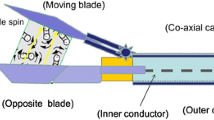Abstract
Background
The use of the ultrasonically activated scalpel (UAS) for vessel closure has attained widespread acceptance in many surgical fields. The aim of our study was to investigate the electron microscopic changes to the blood vessels after the application of UAS.
Methods
We collected 10 arterial and 10 venous segments from vessels that had previously been closed by UAS during abdominal operations. The samples were then prepared for ultramicroscopic analysis Pathological changes in the lumen and the three wall layers of the blood vessel were examined under scanning and transmission electron microscopy.
Results
All of the vessel segments showed similar changes: the presence of a blood clot, endothelial cell condensation, coagulative necrosis of the wall, and charring of the vessel at its tip. The edge of the cut vessel were closed by the coagulation bond, which was tied up by collagen fibrils escaped from denaturation.
Conclusion
When ultrasonic energy is applied to tissues, it changes their structure so as to make a new extracellular matrix.
Similar content being viewed by others
References
Amaral JF (1994) Ultrasonic dissection. Endosc Surg Allied Tech 2: 181–185
Amaral JF (1994) The experimental development of an ultrasonically activated scalpel for laparoscopic use. Surg Laparosc Endosc 4: 92–99
Amaral JF, Chrostek CA (1997) Experimental comparison of the ultrasonically activated scalpel to electrosurgery and laser surgery for laparoscopic use. Min Invas Ther & Allied Technol 6: 324–331
Cotran RS, Robbins SL, Kumar V (1989) Robbin’s pathologic basis of disease. 4th ed Saunders, Philadelphia, pp 17–18
Gossot D, Buess G, Cuschieri A, Leporte E, Lirici M, Marvik R, Meijer D, Melzer A, Schurr MO (1999) Ultrasonic dissection for endoscopic surgery. Surg Endosc 13: 412–417
Hambley R, Hebda PA, Abell E, Cohen BA, Jegasothy BV (1988) Wound healing of skin incisions produced by ultrasonically vibrating knife, scalpel, electrosurgery, and carbon dioxide laser. J Dermatol Surg Oncol 14: 1213–1217
Hayashi A, Takamori S, Matsuo T, Tayama K, Mitsuoka M, Shirouzu K (1999) Experimental and clinical evaluation of the harmonic scalpel in thoracic surgery. Kurume Med J 46.: 25–29
Kanehira E, Kinoshita T, Omura K (1999) Ultrasonic-activated devices for endoscopic surgery. Min Invas Ther & Allied Technol 8: 69–94
Kanehira E, Omura K, Kinoshita T, Kawakami K, Watanabe Y (1999) How secure are the arteries occluded by a newly developed ultrasonically activated device?. Surg Endosc 13: 340–342
Kinoshita T, Kanehira E, Omura K, Kawakami K, Watanabe Y (1999) Experimental study on heat production by a 23.5-KHz ultrasonically activated device for endoscopic surgery. Surg Endosc 13: 621–625
Lantis JC, Durville FM, Connolly R, Schwaitzberg SD (1998) Comparison coagulation modalities in surgery J Laparoendosc Adv Surg Techn 6: 381–394
McCarus SD (1996) Physiologic mechanism of the ultrasonically activated scalpel. J Am Assoc Gynecol Laparosc 3: 601–608
Maruta F, Sugiyama A, Matsushita K, Ispida K., Ikeno T, Shimizu F, Murakami M, Kawasaki S (1999) Use of the harmonic scalpel in open perineal surgery for rectal carcinoma. Dis Colon Rectum 42: 540–542
Otani Y, Ohgami M, Kitajima M (1999) Haemostatic dissection devices: today’s clinical experience and future options. Min Invas Ther & Allied Technol 8: 69–72
Schemmel M, Haefner HK, Selvaggi SM, Warren JS, Termin CS, Hurd WW (1997), Comparison of the ultrasonic scalpel to CO2 laser and electrosurgery in terms of tissue injury and adhesion formation in a rabbit model. Fertil Steril 67: 382–386
Sigel B, Dunn MR (1965) The mechanism of blood vessel closure by high frequency electrocoagulation. Surg Gynecol Obstet 121: 823–831
Suzuki Y, Fujino Y, Tanioka Y, Hori Y, Ueda T, Takeyama Y, Tominaga M, Ku Y, Yamamoto, YM, Kuruda Y (1999) Randomized clinical trial of ultrasonic dissector or conventional division in distal pancreatectomy for non-fibrotic pancreas. Br J Surg 86: 608–611
Trump BF, Mergner WJ (1974) Cell injury. In: Zweifach BW, Grant L, McCluskey RT (eds) The inflammatory process, Academic Press, New York, pp 115–257
Author information
Authors and Affiliations
Additional information
Online publication: 8 February 2002
Rights and permissions
About this article
Cite this article
Foschi, D., Cellerino, P., Corsi, F. et al. The mechanisms of blood vessel closure in humans by the application of ultrasonic energy. Surg Endosc 16, 814–819 (2002). https://doi.org/10.1007/s00464-001-9074-x
Received:
Accepted:
Issue Date:
DOI: https://doi.org/10.1007/s00464-001-9074-x




